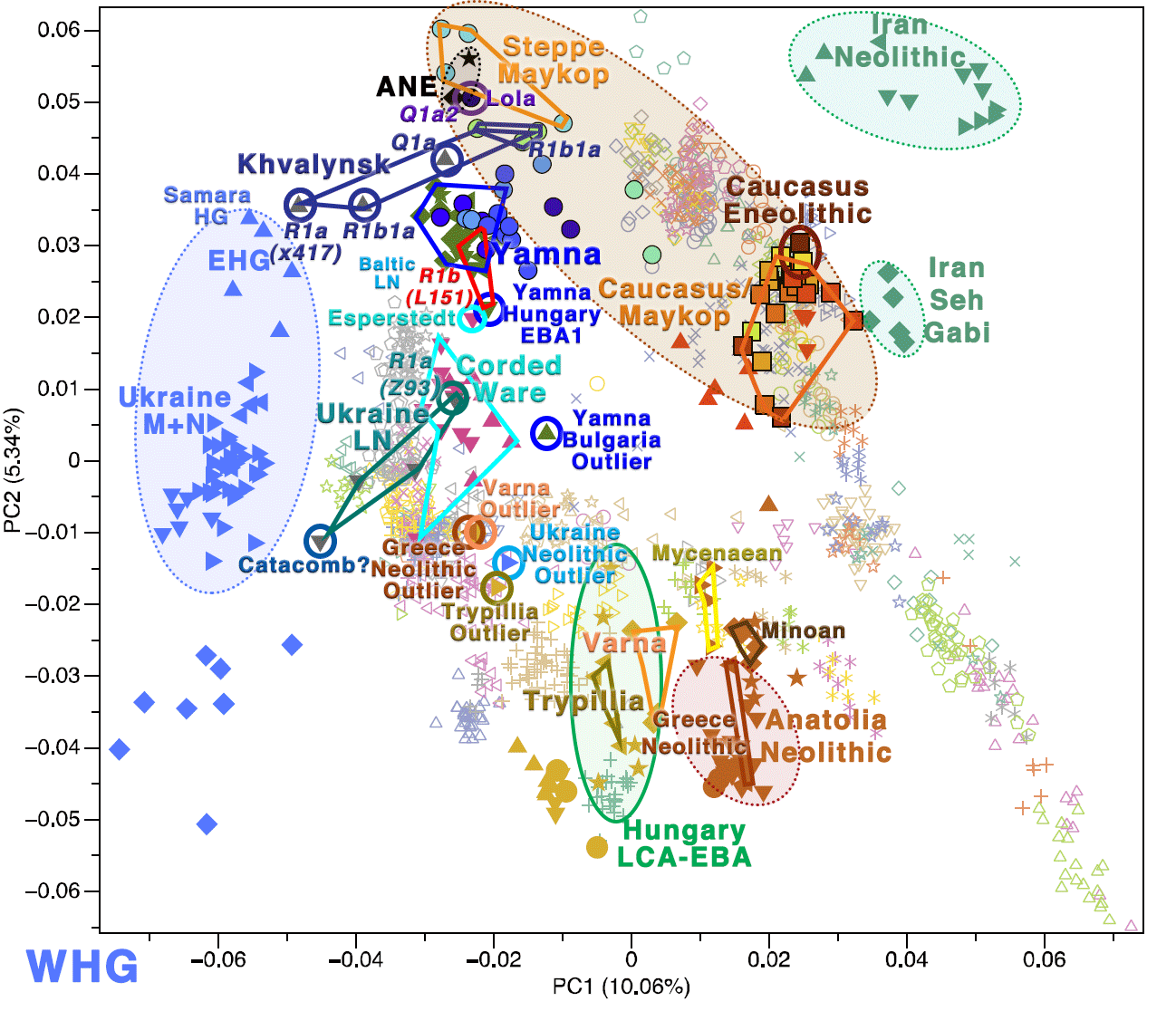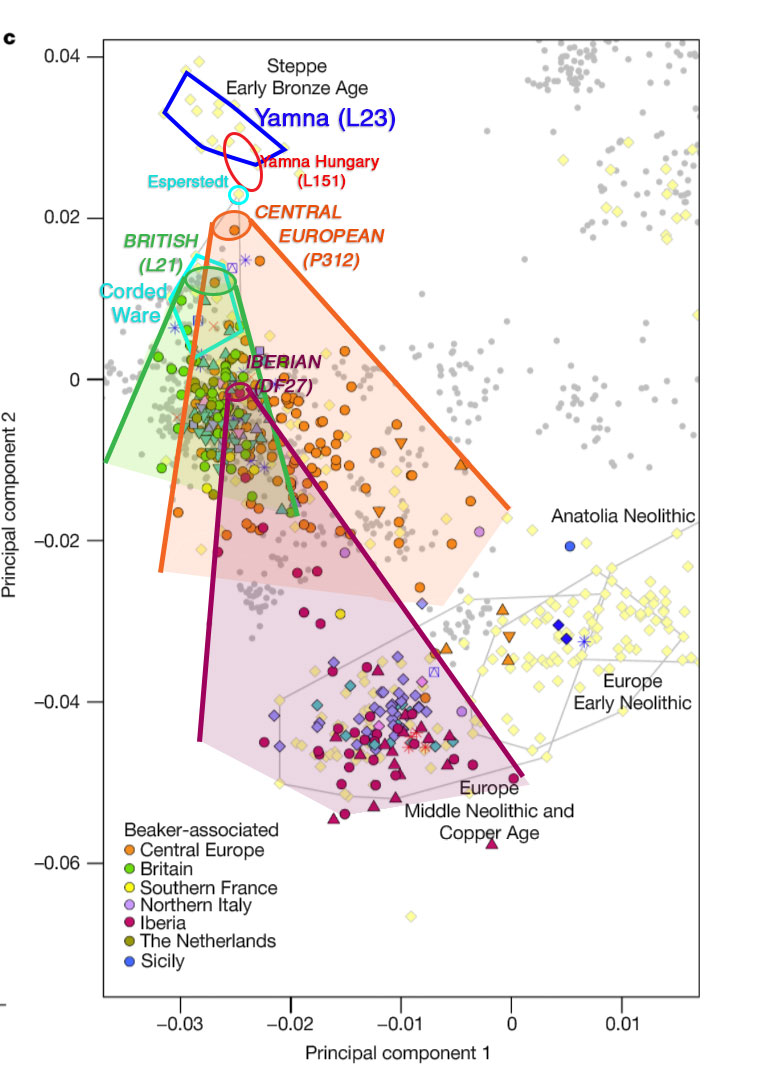Interesting report by Bernard Sécher on Anthrogenica, about the Ph.D. thesis of Samantha Brunel from Institut Jacques Monod, Paris, Paléogénomique des dynamiques des populations humaines sur le territoire Français entre 7000 et 2000 (2018).
NOTE. You can visit Bernard Sécher’s blog on genetic genealogy.
A summary from user Jool, who was there, translated into English by Sécher (slight changes to translation, and emphasis mine):
They have a good hundred samples from the North, Alsace and the Mediterranean coast, from the Mesolithic to the Iron Age.
There is no major surprise compared to the rest of Europe. On the PCA plot, the Mesolithic are with the WHG, the early Neolithics with the first farmers close to the Anatolians. Then there is a small resurgence of hunter-gatherers that moves the Middle Neolithics a little closer to the WHGs.
From the Bronze Age, they have 5 samples with autosomal DNA, all in Bell Beaker archaeological context, which are very spread on the PCA. A sample very high, close to the Yamnaya, a little above the Corded Ware, two samples right in the Central European Bell Beakers, a fairly low just above the Neolithic package, and one last full in the package. The most salient point was that the Y chromosomes of their 12 Bronze Age samples (all Bell Beakers) are all R1b, whereas there was no R1b in the Neolithic samples.
Finally they have samples of the Iron Age that are collected on the PCA plot close to the Bronze Age samples. They could not determine if there is continuity with the Bronze Age, or a partial replacement by a genetically close population.

The sample with likely high “steppe ancestry“, clustering closely to Yamna (more than Corded Ware samples) is then probably an early East Bell Beaker individual, probably from Alsace, or maybe close to the Rhine Delta in the north, rather than from the south, since we already have samples from southern France from Olalde et al. (2018) with high Neolithic ancestry, and samples from the Rhine with elevated steppe ancestry, but not that much.
This specific sample, if confirmed as one of those reported as R1b (then likely R1b-L151), as it seems from the wording of the summary, is key because it would finally link Yamna to East Bell Beaker through Yamna Hungary, all of them very “Yamnaya-like”, and therefore R1b-L151 (hence also R1b-L51) directly to the steppe, and not only to the Carpathian Basin (that is, until we have samples from late Repin or West Yamna…)
NOTE. The only alternative explanation for such elevated steppe ancestry would be an admixture between a ‘less Yamnaya-like’ East Bell Beaker + a Central European Corded Ware sample like the Esperstedt outlier + drift, but I don’t think that alternative is the best explanation of its position in the PCA closer to Yamna in any of the infinite parallel universes, so… Also, the sample from Esperstedt is clearly a late outlier likely influenced by Yamna vanguard settlers from Hungary, not the other way round…
Unexpectedly, then, fully Yamnaya-like individuals are found not only in Yamna Hungary ca. 3000-2500 BC, but also among expanding East Bell Beakers later than 2500 BC. This leaves us with unexplained, not-at-all-Yamnaya-like early Corded Ware samples from ca. 2900 BC on. An explanation based on admixture with locals seems unlikely, seeing how Corded Ware peoples continue a north Pontic cluster, being thus different from Yamna and their ancestors since the Neolithic; and how they remained that way for a long time, up to Sintashta, Srubna, Andronovo, and even later samples… A different, non-Indo-European community it is, then.

Let’s wait and see the Ph.D. thesis, when it’s published, and keep observing in the meantime the absurd reactions of denial, anger, bargaining, and depression (stages of grief) among BBC/R1b=Vasconic and CWC/R1a=Indo-European fans, as if they had lost something (?). Maybe one of these reactions is actually the key to changing reality and going back to the 2000s, who knows…
Featured image: initial expansion of the East Bell Beaker Group, by Volker Heyd (2013).
Related
- “Steppe ancestry” step by step: Khvalynsk, Sredni Stog, Repin, Yamna, Corded Ware
- East Bell Beakers, an in situ admixture of Yamna settlers and GAC-like groups in Hungary
- The Caucasus a genetic and cultural barrier; Yamna dominated by R1b-M269; Yamna settlers in Hungary cluster with Yamna
- Immigration and transhumance in the Early Bronze Age Carpathian Basin
- Steppe and Caucasus Eneolithic: the new keystones of the EHG-CHG-ANE ancestry in steppe groups
- Dzudzuana, Sidelkino, and the Caucasus contribution to the Pontic-Caspian steppe
- On the origin of haplogroup R1b-L51 in late Repin / early Yamna settlers
- On the origin and spread of haplogroup R1a-Z645 from eastern Europe
- Corded Ware culture origins: The Final Frontier
- Sredni Stog, Proto-Corded Ware, and their “steppe admixture”
- Kurgan origins and expansion with Khvalynsk-Novodanilovka chieftains
- About Scepters, Horses, and War: on Khvalynsk migrants in the Caucasus and the Danube
- The concept of “Outlier” in Human Ancestry (III): Late Neolithic samples from the Baltic region and origins of the Corded Ware culture